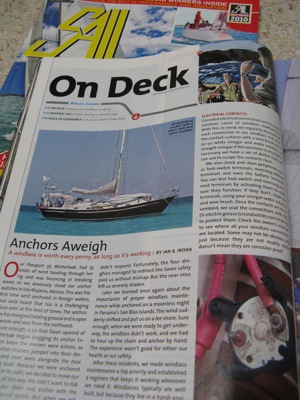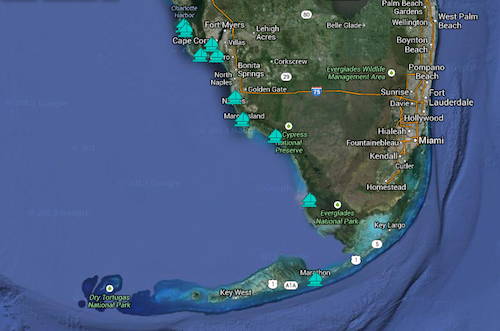Just like their name, sail telltales are there to “tell tales”! Sometimes, spelled tell tails, telltales will provide all sorts of useful sailing information and improve your boat’s sailing performance provided you know the basics of how to read them. Even if you consider yourself “just a cruiser” and don’t care so much about premium sailing performance, paying attention to your telltales will be worthwhile. Especially on a marginal day where you need to get somewhere before dark and would prefer to sail, but motorsail because you’re afraid you might not make it, sailing more efficiently should let you have more time sailing and less time motorsailing.
Don’t have telltales on your sails? If you’re a commuter cruiser like us & take your sails off at the end of every season, it’s easy to add telltales — available here from West Marine – they’re little discs with adhesive and lightweight streamers.
Jib Telltales
Sailing to windward or on a BEAT, racing skippers will sail by the telltales – if the outside telltale is fluttering, they’ll turn the boat closer to the wind and if the inside telltale is fluttering, turn away from the wind.

Most cruisers don’t steer to the telltales, partially because it’s difficult to see jib telltales from inside the cockpit, at least on our boat. But regardless of how you choose to sail, both telltales on both the inside and outside of the jib should stream aft parallel. If you’re pinching slightly, the outside telltale will be streaming back aft parallel to the foot of the sail and the inside telltale will be slightly streaming up steadily, creating a V effect.
Reaching, if the back telltale is fluttering, let the sail out until it streams back aft steadily. If the inside or front telltale is fluttering, pull the sail in until it also streams aft steadily.

If you happen to have telltales on the back edge or leech of the jib keep an eye on those as well. They should be streaming back on the beat especially. If they aren’t, the sail needs to be let out OR your jib tracks need adjusted.
Downwindor 0n a run, sail telltales are largely irrelevant. But if you’re hardcore and have telltales on your shrouds (you probably already know what to do with them, but just in case…) the telltale on your side shroud should point into the slot (the slot is the gap between the main & the jib). For the most part, this is accomplished by steering the boat not adjusting the sails. If the telltale goes toward the mast, you’re sailing too high and need fall off. If the telltail continues to point toward the bow, it may be time to jibe or you can come up closer to the wind.

Mainsail Telltales
Most cruising boats, ours included, don’t have telltales on the leech (back edge) of the mainsail. Actually we had them, but over the years they’ve fallen off & we haven’t replaced them. But if you do have them, they could be streaming aft or sometimes stalling out as you’re sailing to windward. Off the wind on a reach, the mainsail leech telltales should be flowing aft, if not the sail needs to be adjusted either out or in until they stream aft.
By paying attention to your telltales, you’ll make your boat sail faster and more efficient — especially important on slower boats like our 12 ton Passport — in order to get to our next destination during daylight — and enjoy the pleasure of turning off the rumble from the diesel instead of motorsailing.
Anyone have more to add? Please leave a comment & join the discussion! Cheers! Jan














Over my sailing life of 30 + years I have found that the main sail tell tales to be very important for good boat speed. I have noticed that most sail boats over trim the main by insisting that the boom be on the centre line by tightening on the main sheet, and pulling down on the sail leech. This causes the sail to be chocked off and not providing any power. Having tell tales on the leach at the upper batten you open the leach with the main sheet this lets the sail breath and create sail power.
John
John — we absolutely agree and exactly what we do with our one design Y Flyer, scow racing boat. Most people do choke off the main, and if there are no telltales on the leech at the upper batten is an excellent way to prevent choking the speed. THANKS for adding your comment! Cheers! Jan & David
when you said – “Sailing to windwardor on a BEAT, racing skippers will sail by the telltales – if the outside telltale is fluttering, they’ll turn the boat farther off the wind and if the inside telltale is fluttering, turn closer to the wind.”
this is completely the wrong way round. the opposite is true.
Graeme – you are absolutely right – I knew what I meant, but didn’t write it correctly. I cannot believe that no one has noticed the gaff before now. Thanks for pointing out the error. (more than slightly embarrassed!!!). Cheers! Jan